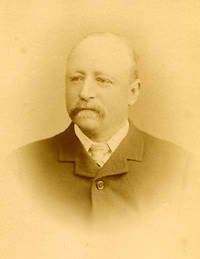Nationality Scottish Known for Lighthouses | Name Richard Brunton Books Building Japan, 1868-1876 | |
 | ||
Occupation Civil engineer, railway engineer, foreign advisor to Japan Died April 23, 1901, London, United Kingdom | ||
Richard Henry Brunton FRGS MICE (26 December 1841 – 24 April 1901) was the so-called "Father of Japanese lighthouses". Brunton was born in Muchalls, Kincardineshire, Scotland. He was employed by the government of Meiji period Japan as a foreign advisor (o-yatoi gaikokujin), primarily to build lighthouses.
Contents
Over a period of seven and a half years he designed and supervised the building of 26 Japanese lighthouses in the Western style, which became known as Brunton's "children". To operate the lighthouses he established a system of lighthouse keepers, based on the one used in Scotland. He also helped found Japan's first school of civil engineering. In 1871, he was received by Emperor Meiji in recognition of his efforts.
Early life
Brunton was born in the Coastguard House (now 11 Marine Terrace) at Muchalls, Fetteresso in The Mearns. After training as a railway engineer he joined the Stevenson brothers (David and Thomas Stevenson) who were engaged by the British government to build lighthouses.
Life in Japan
Under pressure from British minister Sir Harry Parkes to fulfil its obligations to make the waters and harbors of Japan safe for shipping, the Tokugawa shogunate hired the Edinburgh-based firm of D. and T. Stevenson to chart coastal waters and to build lighthouses where appropriate. The project had already begun under French foreign advisor Léonce Verny, but was not proceeding fast enough for the British.
Brunton was sent from Edinburgh in August 1868 to head the project after being recommended to the Japanese government by the Stevensons, despite the fact that he had no experience in lighthouse building at all. He was accompanied by his wife, sister-in-law and two assistants. The party received word while docked at Aden of the fall of the Tokugawa shogunate and its replacement by the Meiji government, and decided to continue on to Japan, reasoning that the new government was still bound by the international commitments of its predecessor. Over the next seven and a half years he designed and supervised the building of 26 Japanese lighthouses in the Western style, along with two lightvessels. An obituary published in the journal of the Institution of Civil Engineers states 'in ten years he had he executed 50 lighthouses'.
There had been Japanese lighthouses before then, but they were short and squat buildings, such as the old Shirasu lighthouse now in the grounds of Kokura castle in Kitakyushu.
Brunton also established a system of lighthouse keepers, modeled on the Northern Lighthouse Board in Scotland.
Aside from his work on lighthouses around Japan, Brunton also surveyed and drew the first detailed maps of Yokohama, planned its sewage system, street paving and gas lights, established a telegraph system, and designed and built the settlement's first iron bridge. He also helped found Japan's first school of civil engineering. In recognition of his efforts, he was received by Emperor Meiji in an audience in 1871.
Brunton returned to London on a leave of absence in July 1872, and was enlisted to assist the Iwakura Mission during its visit. In September, Brunton took Ito Hirobumi and a group of his assistants to visit 28 factories around London making a variety of manufactured goods, and continued on to Birmingham, Manchester and Liverpool before rejoining the main group of the Iwakura Mission in Edinburgh in early October.
Return to Britain
After disagreeing with Japanese officials he left Japan in March, 1876, later receiving a prize for his paper "Japan Lights".
On his return he first set up in Glasgow for Young's Paraffin Oil, before moving to South London in 1881 making architectural plasterwork, where he remained until his death. He is buried in West Norwood Cemetery, where his marble memorial there was restored by Yokohama Chamber of Commerce in 1991.
List of Brunton's Japanese Lighthouses
The names of the 26 lighthouses (Brunton's "children") constructed by Brunton, in order of north to south, and the names of their present locations after mergers of towns etc.
Memoir
Brunton wrote a memoir of his time in Japan, titled Pioneer Engineering in Japan: A Record of Work in helping to Re-Lay the Foundations of Japanese Empire (1868-1876). However, it was not published until the 1990s, when it was printed by separate publishers under two different names: Building Japan 1868-1876 and Schoolmaster to an Empire: Richard Henry Brunton in Meiji Japan, 1868-1876. (See below.)
The former, containing the text (with some modified spellings) as edited by William Elliot Griffis at the turn of the twentieth century, contains plates with photos and illustrations. The latter however, purports to be based on a manuscript predating the heavy editing of Griffis, while retaining updated versions of Griffis's footnotes.
In his memoir, Brunton describes in some detail the burial of Frank Toovey Lake, a midshipman who was sailing with him on HMS Manilla when he was making his first survey of locations to site lighthouses. His high regard for the care that the islanders gave to the grave was, as he himself admitted in his book, in contrast to his general impression of the Japanese.
